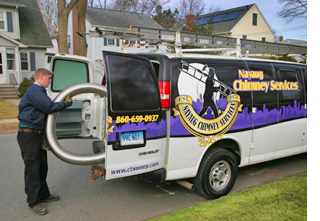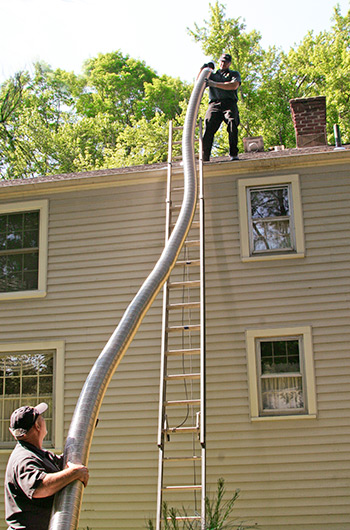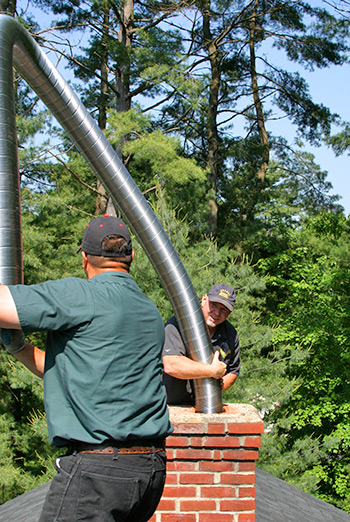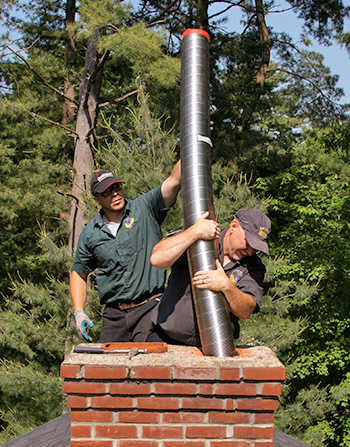Chimney Liner – Professional Chimney Liner Installation by Chimney Sweeps
 You’ll see our brightly marked chimney sweep trucks on their way to provide chimney repairs services like chimney relining to residents in Glastonbury, Newington, Hebron, Portland, East Hampton, Vernon, Rockville, Ellington, Andover, and more!
You’ll see our brightly marked chimney sweep trucks on their way to provide chimney repairs services like chimney relining to residents in Glastonbury, Newington, Hebron, Portland, East Hampton, Vernon, Rockville, Ellington, Andover, and more!
One of the most crucial components of your whole chimney system is the chimney liner. Its main function is to safely remove smoke and combustibles from your home. After years of use chimney liners can become damaged, cracked, or deteriorated. This common problem could potentially cause safety issues such as a chimney fire or the backup of harmful gases into your home. During your annual inspection, our certified chimney sweep technicians will closely examine the condition of your liner and determine whether it is in need of repair or replacement.
We Are Chimney Lining Professionals
Our popular stainless steel liners withstand the corrosive environment and contain the high heat present in the flues. All of our chimney liners meet or surpass UL safety standards. New liners come with a lifetime warranty that protects you against damage caused by both fire and corrosion.
 What is the Chimney Liner?
What is the Chimney Liner?
The liner is the channel that all smoke and gases pass through to exit your home. The chimney liner is inside the chimney and should be a separate component of the chimney construction. The inside of your chimney needs to be covered with a non-combustible lining that can vent the toxic hot gases and particles produced by your fireplace, stove or furnace. These linings can be made of stainless steel, casted masonry material, clay tiles or aluminum. The flue, or the channel that the chimney is vented through must be free of any cracks, holes or deterioration to keep your system running safely and efficiently. Any breeches in the integrity of the lining can allow combustible materials that travel up the flue to enter into attics, ceilings or walls adjacent to the chimney.
What are the sign that my chimney lining may be in trouble?
If the draft is reduced in your chimney it will lose the power to draw the smoke out and away from your living area. If smoke or gases waft into your main living space, there could be an issue with your chimney liner. Smelly fireplaces can also indicate a large build-up of creosote and soot, possibly signaling a liner issue as well.
Remember, the inside of your chimney needs to be maintained. Proper cleaning and repairs made over the life of your chimney will prevent more costly fixes and dangers that arise from neglect. The sulfur in soot may become wet causing corrosion to occur, even in metal liners. A proper chimney cap can help to prevent much of this damage. Clay linings can chip and flake over the years and start to develop cracks and gaps. An annual inspection will determine the condition of your chimney liner and a certified chimney sweep will be able to make recommendations when it is time to replace or repair your lining.
 When should I have a Chimney Relining performed?
When should I have a Chimney Relining performed?
If you are converting to a new furnace, appliance or type of fuel, you need to make sure that the liner that is installed matches the venting output requirements of the new system. Many times a damaged or deteriorating chimney can be repaired from the inside by installing a new lining (or relining). Wind damage, age settling and lightning may have damaged your chimney and relining can sometimes be the solution for you. Remember, the number one cause of chimney fires is linings that have failed. Many older chimneys may not even have a safe lining at all! These chimneys can still be upgraded by adding a new chimney lining. The cost of tearing apart a weak chimney and rebuilding it entirely can be prohibitive for many homeowners, but a chimney relining can resolve many hazardous conditions and add life to your old chimney.
The NFPA (National Fire Protection Association) code requires masonry chimneys to have a liner. When we inspect your chimney we will recommend the best choice for your individual situation and tell you the reasons behind our suggestions.
Types of Chimney Liners:
Cast Liners
This method is used many times when the chimney needs strengthening, such as older deteriorated chimneys or damaged chimneys. An inflatable oval form is inserted into the chimney and then a masonry material is poured around the form. The form is then deflated and removed, leaving a new seamless channel for your flue and chimney lining. This method adds strength and stability to chimneys that are structurally weak.
Clay Tile Liners
If your chimney is fairly short and straight it may be a good candidate for a tile liner. This method is quite common with new construction and is one of the more economical solutions. Clay tile liners are also found in many older homes with masonry chimneys. Unfortunately, once these older tiles deteriorate – retiling may be quite difficult.
 Stainless Steel Liners
Stainless Steel Liners
Woodstoves and some types of furnaces may require a stainless steel liner to meet their recommended venting requirements. A round steel liner is inserted down the chimney and serves as your flue pipe. The material can be rigid or flexible depending on the particular chimney specifications that the chimney liner is going in. Chimneys with jogs or offsets will need a flexible solution to fit around the landscape inside the flue area. Heavier liners are generally made of 316L stainless steel, while the lighter varieties are made with 316ti stainless steel (contains titanium). Titanium adds protection from corrosion and high temperatures. Most all stainless steel liners can withstand extremely high heat, making them a good choice.
Aluminum Liners
Certain types of gas appliances can use aluminum liners which are similar to stainless steel configurations. These liners are not appropriate for most common applications or wood burning fireplaces.
FAQ: Should my metal liner be insulated?
Yes, metal liners will perform better if they are insulated. They can be wrapped in a ceramic wool covering before the liner is installed in the chimney or a vermiculite coating that is poured down the chimney after installation, drying around the liner.

 Tap to Call Now
Tap to Call Now



